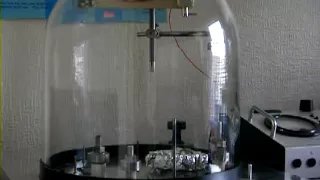Terminal Velocity and Friction Due to Air
claimed by cshimkus3
Acceleration of Falling Objects
When you drop an object from a certain height off the ground, you can observe that the speed of the object does not remain constant throughout that object's free fall. The object's speed changes as it falls and we know from the momentum principle that this is due to a net force acting on the object( Fnet = dp/dt ). If you drop an object from a tall enough starting height, you can also observe that the acceleration of the object is not constant either, so one can conclude that the net force on the object is not constant. An object falling towards the Earth's surface will not accelerate indefinitely, but will reach what is called ' ' terminal velocity ' '. Odds are you are familiar with the force of gravity, the force that holds you to Earth's surface and causes an object to accelerate initially downward. Gravity is defined as F=mg, where g is the acceleration constant of 9.8 m/s^2 (on Earth), and is a constant force. Another force, friction, is also acting on a falling object, however. This friction is due to the contact between molecules of the falling object and air molecules and is non-constant through the objects free-fall. In the following sections we will look into greater detail the effects of friction due to air.
Falling Objects in a Vacuum
As stated above, the force due to gravity on an object is constant. This can be proven by an object that is in free fall and is also in a vacuum. When an object is falling within a vacuum, it can be observed to have constant acceleration of 9.8 m/s^2 regardless of its mass or size. In the following video, a feather and a ball bearing are dropped inside a vacuum. See how both objects fall at the same rate. (Click on the picture)
Friction Due to Air
The friction due to air is a non-constant force on a falling object, and is related to multiple factors, such as cross-sectional area, the objects velocity, and the density of air. The force of air on a falling object is defined by the following equation in the opposite direction of the objects motion:
So, when the force of air comes into play, we see the the feather and ball bearing will not fall at the same rate because they have different cross sectional areas. The following video shows a feather and ball bearing being dropped in both scenarios.

Where does that energy go?
How do we visualize or predict using this topic. Consider embedding some vpython code here Teach hands-on with GlowScript
A Graphical Interpretation
The first law of thermodynamics defines the internal energy (E) as equal to the difference between heat transfer (Q) into a system and work (W) done by the system. Heat removed from a system would be given a negative sign and heat applied to the system would be given a positive sign. Internal energy can be converted into other types of energy because it acts like potential energy. Heat and work, however, cannot be stored or conserved independently because they depend on the process. This allows for many different possible states of a system to exist. There can be a process known as the adiabatic process in which there is no heat transfer. This occurs when a system is full insulated from the outside environment. The implementation of this law also brings about another useful state variable, enthalpy.
Examples
Reversible process: Ideally forcing a flow through a constricted pipe, where there are no boundary layers. As the flow moves through the constriction, the pressure, volume and temperature change, but they return to their normal values once they hit the downstream. This return to the variables' original values allows there to be no change in entropy. It is often known as an isentropic process.
Irreversible process: When a hot object and cold object are put in contact with each other, eventually the heat from the hot object will transfer to the cold object and the two will reach the same temperature and stay constant at that temperature, reaching equilibrium. However, once those objects are separated, they will remain at that equilibrium temperature until something else acts upon it. The objects do not go back to their original temperatures so there is a change in entropy.
Connectedness
- How is this topic connected to something that you are interested in?
- How is it connected to your major?
- Is there an interesting industrial application?
History
Thermodynamics was brought up as a science in the 18th and 19th centuries. However, it was first brought up by Galilei, who introduced the concept of temperature and invented the first thermometer. G. Black first introduced the word 'thermodynamics'. Later, G. Wilke introduced another unit of measurement known as the calorie that measures heat. The idea of thermodynamics was brought up by Nicolas Leonard Sadi Carnot. He is often known as "the father of thermodynamics". It all began with the development of the steam engine during the Industrial Revolution. He devised an ideal cycle of operation. During his observations and experimentations, he had the incorrect notion that heat is conserved, however he was able to lay down theorems that led to the development of thermodynamics. In the 20th century, the science of thermodynamics became a conventional term and a basic division of physics. Thermodynamics dealt with the study of general properties of physical systems under equilibrium and the conditions necessary to obtain equilibrium.
See also
Are there related topics or categories in this wiki resource for the curious reader to explore? How does this topic fit into that context?
Further reading
Books, Articles or other print media on this topic
External links
Internet resources on this topic
References
https://www.grc.nasa.gov/www/k-12/airplane/thermo0.html http://hyperphysics.phy-astr.gsu.edu/hbase/thermo/thereq.html https://www.grc.nasa.gov/www/k-12/airplane/thermo2.html http://www.phys.nthu.edu.tw/~thschang/notes/GP21.pdf http://www.eoearth.org/view/article/153532/

